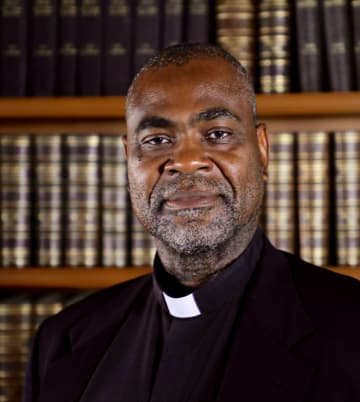Education
- B.A. Philosophy – Institut Saint Pierre Canisius (Kinshasa, Democratic Republic of Congo) – 1989
- M.A. Celestial Mechanics – University of Namur (Belgium) – 1994
- B.A. Theology –Centre Sevres (Paris, France) – 1997
- D.E.A. Celestial Mechanics – Institute of Celestial Mechanics IMCEE, Observatory of Paris, France – 2001
- M.A. Theology – Centre Sevres (Paris, France) – 2003
- Ph.D. Astronomy – University of Western Ontario (Canada) – 2010
Memberships
- International Astronomical Union
- American Astronomical Society Division for Planetary Science
- European Planetary Science Congress
Background
Fr. Jean-Baptiste Kikwaya Eluo S.J. was born in the Democratic Republic of Congo in 1965. He taught mathematics at the junior school, Institut Lisanga, in SIA, Bandundo, in the Democratic Republic of Congo from 1983-84 before joining the Society of Jesus in the Province of Central Africa in 1984.
He studied at Institut Saint Pierre Canisius (the Superior Philosophical Institute) in Kimwenza, Democratic Republic of Congo from 1986 to 1989 where he earned at B.A. in philosophy (honor Bachelor of Philosophy from the Gregorian University). He obtained a Master’s degree in celestial mechanics from the University of Namur, Belgium in 1994 and he studied at the Sevres Centre, in Paris, France, where he earned a BA in theology in 1997. He was ordained to the priesthood in 1998 while teaching at ISAV (Institut Superieur d’Agro-Veterinaire) in Kinshasa, Democratic Republic of Congo (1997-99).
After ordination, he earned a diploma (DEA – Diplome d’Etudes Approfondies) in Astronomy and Celestial Mechanics at the Institute of Celestial Mechanics (IMCEE) from the Observatory of Paris, France in 2001 specializing in binary systems and asteroids and an MA in theology from the Centre Sevres in Paris, France in 2003. He completed his PhD in Astronomy in 2010 at the University of Western Ontario, Canada. The topic of his thesis is “The bulk density of small meteoroids.”
Research Interests
Fr. Kikwaya is working on meteors, fireballs, and Near Earth Objects. For meteors, he is interested in determining the bulk density of very faint meteors (millimeter size meteors) using a model of ablation based on the conception of meteor as a dustball. For fireballs (meteors brighter than 3 magnitudes) captured nightly by three cameras set around Tucson (Kitt Peak, Mt Lemmon, and Mount Hopkins), he estimates the flux of different major showers. For Near Earth Objects, he is interested in NEOs with H larger than 22. He measures their spin rates (rotation) and also determines their colors using BVIR broad band filters.
Recent Peer-Reviewed Publications
- Kikwaya Eluo, Jean-Baptiste, Hergenrother, Carl W. Lightcurves and Colors of Seven Small Near-Earth Asteroids: 2023 LQ1, 2023 LT1, 2023 MC, 2023 VQ5, 2023 VE6, 2023 VF6, 2023 VV7
- Kikwaya Eluo, Jean-Baptiste, Hergenrother, Carl W. Lightcurves and Colors of Four Small Near-Earth Asteroids: 2020 BV14 2023 HH3, 2023 HT3, 2023 KQ. ADS, Oct. 2023
- KIKWAYA, J.B., Campbell-Brown, M., and Brown, P.G. 2011. Bulk density of small meteoroids. A&A 530, A113.
- KIKWAYA, J.B., Weryk, R.J., Campbell-Brown, M., and Brown, P.G. 2010. A model for saturation correction in meteor photometry. MNRAS 404, 387-398.
- KIKWAYA, J.B., Campbell-Brown, M., Brown, P.G., and Weryk, R.J. 2009. Physical characteristics of very small meteoroids. A&A 497, 851-867.

